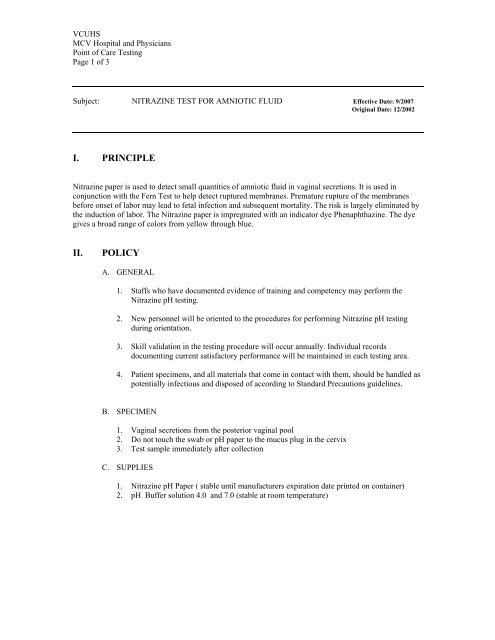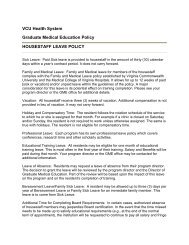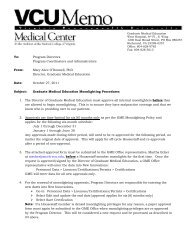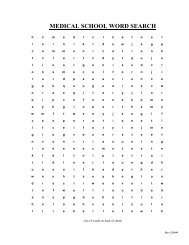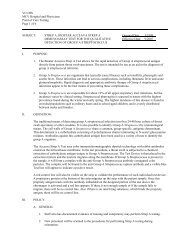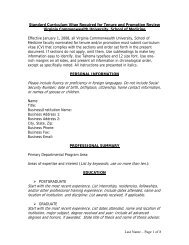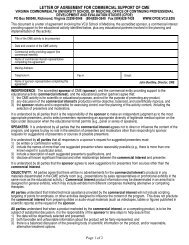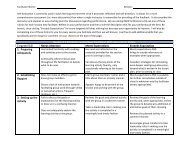NITRAZINE TEST FOR AMNIOTIC FLUID
NITRAZINE TEST FOR AMNIOTIC FLUID
NITRAZINE TEST FOR AMNIOTIC FLUID
Create successful ePaper yourself
Turn your PDF publications into a flip-book with our unique Google optimized e-Paper software.
VCUHSMCV Hospital and PhysiciansPoint of Care TestingPage 1 of 3Subject: <strong>NITRAZINE</strong> <strong>TEST</strong> <strong>FOR</strong> <strong>AMNIOTIC</strong> <strong>FLUID</strong> Effective Date: 9/2007Original Date: 12/2002I. PRINCIPLENitrazine paper is used to detect small quantities of amniotic fluid in vaginal secretions. It is used inconjunction with the Fern Test to help detect ruptured membranes. Premature rupture of the membranesbefore onset of labor may lead to fetal infection and subsequent mortality. The risk is largely eliminated bythe induction of labor. The Nitrazine paper is impregnated with an indicator dye Phenaphthazine. The dyegives a broad range of colors from yellow through blue.II.POLICYA. GENERAL1. Staffs who have documented evidence of training and competency may perform theNitrazine pH testing.2. New personnel will be oriented to the procedures for performing Nitrazine pH testingduring orientation.3. Skill validation in the testing procedure will occur annually. Individual recordsdocumenting current satisfactory performance will be maintained in each testing area.4. Patient specimens, and all materials that come in contact with them, should be handled aspotentially infectious and disposed of according to Standard Precautions guidelines.B. SPECIMEN1. Vaginal secretions from the posterior vaginal pool2. Do not touch the swab or pH paper to the mucus plug in the cervix3. Test sample immediately after collectionC. SUPPLIES1. Nitrazine pH Paper ( stable until manufacturers expiration date printed on container)2. pH Buffer solution 4.0 and 7.0 (stable at room temperature)
VCUHSMCV Hospital and PhysiciansPoint of Care TestingPage 2 of 3D. QUALITY ASSESSMENT1. The Nitrazine pH paper will be checked:a. Each day of patient testingb. Each time a new container of Nitrazine pH paper is opened2. pH Buffer Solutions (4.0) and (7.0) will be used for quality control testing. pH Buffer solutionmaybe obtained from the POCT office.III.PROCEDURESQuality Control Testing:RequisitesNitrazine pH paperpH Buffer Solution (4)pH Buffer Solution (7)GlovesProcedures:1. Wash hands with soap and friction for 15 seconds. Put on gloves.2. Tear off pieces of Nitrazine paper of desired length.3. Apply one drop of buffer to a strip of Nitrazine paper. Shake off excess buffer.4. Immediately match strip color with the closest color on the dispenser color chart.5. Record date,initials, Nitrazine paper lot number, expiration date, and the quality control results on theQC log sheet located in the POCT book.6. Buffer pH results must be identical to the manufacturer results.7. If QC fails, repeat. If QC fails a second time, do not use Nitrazine paper for patient testing. Discardand open a new box.8. Repeat the above procedure for subsequent buffers.Patient TestingRequisitesNitrazine pH paperGlovesTesting Procedure1. Wash hands with soap and friction for 15 seconds. Put on gloves.2. Write the patients name and medical record number on the specimen container3. Tear off a piece of Nitrazine paper of desired length4. Apply patient sample from swab onto the strip of Nitrazine paper.5. Immediately match the color on the strip with the closest color on the dispenser color chart.
VCUHSMCV Hospital and PhysiciansPoint of Care TestingPage 3 of 3Result Reporting1. Record patient result in patients chart2. Normal vaginal secretions have a pH of 4.5 to 5.5, whereas amniotic fluid has a pH of 7.0 to 7.5. Whenthe membranes rupture, the amniotic fluid leaks into the vagina and raises the pH of the vaginalsecretions3. If the pH paper color is yellow to olive green, the corresponding pH is 4.5 to 6.0. The test is negativefor amniotic fluid.4. If the pH paper color is blue-green to deep blue, the corresponding pH is 6.5 to 7.5. The test is positivefor amniotic fluid.5. The Nitrazine test is highly sensitive but not specific.6. If the Nitrazine and Fern Test are positive, probable membrane rupture has occurred.7. If the Nitrazine Test is negative but the Fern test is positive, there is probable rupture of themembranes due to the Fern Test’s greater specificity.8. If the Nitrazine Test is positive and the Fern Test is negative, a second specimen should be collected.IV.INTERFERENCES1. False positive results may occur from specimen contamination due to heavy vaginal discharge, blood,cervical mucus, semen, alkaline urine, and soap.2. False negative results may be produced by prolonged rupture of membranes (longer than 24 hours) orwhen a small volume of fluid has leaked.3. Specimen contamination will result in erroneous pH results.V. REFERENCE RANGEAmniotic fluid has a pH of 7.0-7.5VI.REFERENCES1. Dr. Joseph F. Borzelleca, Assistant Professor of OB/GYN, VCU Health Systems2. Oregon Health and Science University, Health Care System, POCT, Nitrazine Procedure


